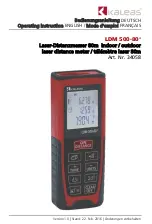
Elma BM 251s-257s
side 23
English
Elma 251s-257s
Safety
Terms in this manual
WARNING
identifies conditions and actions that could result in serious injury or even death to the
user.
CAUTION
identifies conditions and actions that could cause damage or malfunction in the instrument.
This manual contains information and warnings that must be followed for operating the instrument safely
and maintaining the instrument in a safe operating condition. If the instrument is used in a manner not
specified by the manufacturer, the protection provided by the instrument may be impaired. The meter is
intended only for indoor use.
The meter protection rating, against the users, is double insulation per IEC/UL/EN61010-1 Ed. 3.0,
IEC/EN61010-2-030 Ed. 1.0, IEC/EN61010-2-033 Ed. 1.0, IEC/UL/EN61010-031 Ed. 1.1 and CAN/CSA-
C22.2 No. 61010-1-12 Ed. 3.0 to Category II 1000V, CAT III 600V and CAT IV 300V AC & DC.
Terminals (to COM) measurement category:
V / mA
A / A :Category II 1000V, CAT III 600V and CAT IV 300V AC & DC.
Per IEC61010-1 2nd Ed. (2001) Measurement Category
Measurement Category IV (CAT IV)
is for measurements performed at the source of the low-
voltage installation. Examples are electricity meters and measurements on primary overcurrent protection
devices and ripple control units.
Measurement Category III (CAT III)
is for measurements performed in the building installation.
Examples are measurements on distribution boards, circuit- breakers, wiring, including cables, bus-bars,
junction boxes, switches, socket-outlets in the fixed installation, and equipment for industrial use and
some other equipment, for example, stationary motors with permanent connection to the fixed installation.
Measurement Category II (CAT II)
is for measurements performed on circuits directly connected
to the low voltage installation. Examples are measurements on household appliances, portable tools and
similar equipment.
WARNING
To reduce the risk of fire or electric shock, do not expose this product to rain or moisture. To avoid
electrical shock hazard, observe the proper safety precautions when working with voltages above 60
VDC or 30 VAC rms. These voltage levels pose a potential shock hazard to the user. Do not touch test
lead tips or the circuit being tested while power is applied to the circuit being measured. Keep your
fingers behind the finger guards of the test leads during measurement. Inspect test leads, connectors,
and probes for damaged insulation or exposed metal before using the instrument. If any defects are
found, replace them immediately. Do not measure any current that exceeds the current rating of the
protection fuse. Do not attempt a current measurement to any circuit where the open circuit voltage is
above the protection fuse voltage rating. Suspected open circuit voltage should be checked with voltage
functions. Never attempt a voltage measurement with the test lead inserted into the
A/mA or A input
jack. Only replace the blown fuse with the proper rating as specified in this manual. Only use the test lead
provided with the equipment or UL Listed Probe Assembly rated CAT III 1000V or better.
CAUTION
Disconnect the test leads from the test points before changing functions. Always set the instrument to the
highest range and work downward for an unknown value when using manual ranging mode.
Содержание 5706445410286
Страница 35: ......
Страница 36: ...20131017MD v1 0 20220708 hlo v 1 1...














































